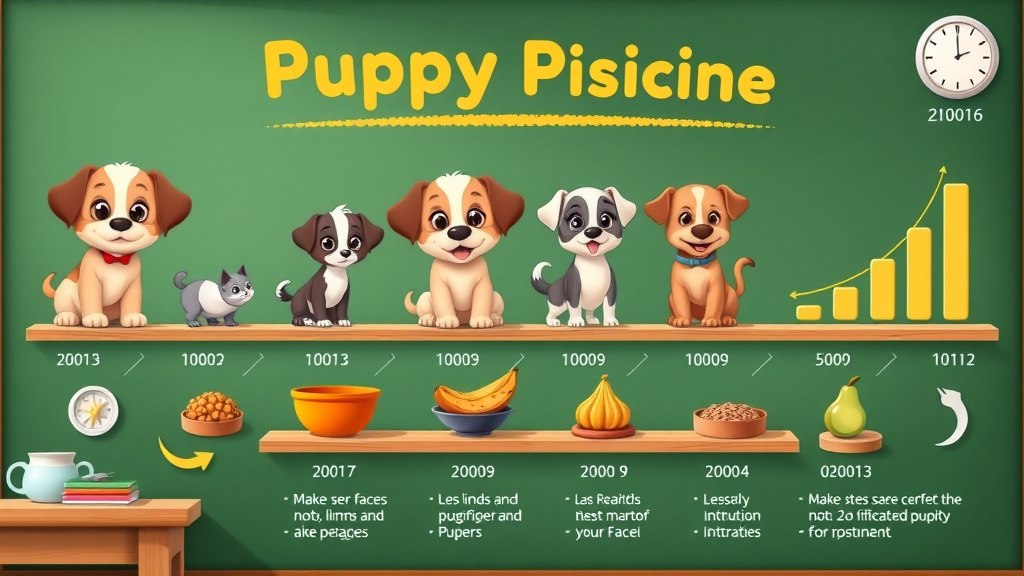Did you know that over 60% of puppies face stunted growth due to preventable nutrition mistakes? As a pet parent, unlocking the secrets behind puppy nutrition basics isn’t just about filling a bowl—it’s about shaping your growing pup’s future health, energy, and happiness. This guide will empower you to confidently fuel your puppy’s journey from playful explorer to thriving adult, with actionable advice grounded in science and real-life veterinary expertise. Ready to feed your puppy right? Let’s jump in.
Startling Research: Why Mastering Puppy Nutrition Basics Matters for Every Pet Parent
-
Did you know? According to veterinary science, over 60% of puppies experience preventable growth setbacks due to improper nutrition. Discover how getting puppy nutrition basics right can shape your growing pup for life.

The Fundamentals of Puppy Nutrition Basics: Essential Nutritional Requirements for Every Growing Pup
At the heart of puppy nutrition basics is understanding what a growing pup truly needs. Puppies aren’t just small versions of adult dogs—their rapid development requires a distinct blend of nutrients, including increased energy, higher quality protein, and key minerals like calcium and phosphorus. A balanced diet supports strong bones, sharp minds, and healthy immune systems, helping your pet avoid preventable setbacks in these crucial months.
While it might seem tempting to offer regular dog food or leftovers, only specialized puppy food supplies the exact amino acid and fatty acid balance suited to a growing pup's metabolic needs. Proper nutrition means more than calories; it’s the right mix of vitamins and minerals that fuel organ development and resilience.
Below, we’ll explore the differences between dog food and puppy food , the essential role of each nutrient, and why a complete and balanced diet is non-negotiable for your young companion’s start in life.
Understanding Puppy Nutritional Requirements: Dog Food vs. Puppy Food
One of the core decisions every pet parent faces is choosing between dog food and puppy food . While adult dog food can meet the needs of fully grown canines, puppies have much higher requirements for protein, energy, and specific nutrients during the first year of life. Puppy food is carefully formulated with higher concentrations of protein and fat, as well as critical nutrients like DHA—an essential fatty acid for brain and eye development.
In contrast, adult dog food usually contains reduced protein, calories, and certain minerals, which may not adequately fuel a puppy’s active growth phase. Feeding your puppy the right food ensures their nutritional requirements for growth, immunity, and energy are consistently met. Look for pet foods with an AAFCO statement confirming they are suitable for puppies or all life stages.

Key Vitamins and Minerals in Puppy Nutrition Basics
High-quality puppy food must provide a precise blend of key vitamins and minerals . Calcium and phosphorus support skeletal growth, while vitamins A, D, and E contribute to healthy vision, resilience, and immune system function. The right balance of trace minerals such as zinc, copper, and selenium further supports robust physical and neurological development.
Puppies also benefit from enriched levels of B vitamins to support metabolic activity and optimal conversion of food to energy. Deficiencies or excesses, especially in calcium and vitamin D, can cause skeletal abnormalities—a risk particularly in large breed puppies, underscoring the importance of “ complete and balanced ” nutrition tailored to your growing companion's life stage.
Balanced Diets: The Science Behind Complete and Balanced Puppy Nutrition
Achieving a balanced diet is crucial for your puppy’s health. Complete and balanced puppy pet food ensures your growing pup receives all the essential nutrients in the right proportions—amino acids, fatty acids, and micronutrients—to thrive. The Association of American Feed Control Officials (AAFCO) provides guidelines that quality puppy foods follow, guaranteeing nutritional adequacy so your pup’s needs are met at every meal.
Relying on home-cooked or supplemental diets can make it difficult to consistently meet a puppy’s complex dietary needs. Instead, opt for reputable commercial puppy foods with an AAFCO statement, especially for first-time pet parents. This approach helps avoid growth issues and supports optimal cognitive, skeletal, and immune system development, laying the groundwork for a healthy life stage transition.
Decoding Dog Food: How Puppy Food Differs and Why it Matters
Formulating Puppy Food for Breed Puppies: Protein, Fat, Calcium, and More
The ideal puppy food formula takes breed size, growth rate, and activity level into consideration. For all puppies, protein is paramount—typically making up 22–32% of the diet (dry matter)—to supply essential amino acids for muscle and tissue growth. Fat content, required for energy, generally ranges from 10–25%, and should include omega-3 and -6 fatty acids for healthy skin and cognitive development.
Not all puppies need the same levels: large breed puppies require careful calcium and phosphorus regulation to prevent bone disorders, while small breed puppies may require more calories per pound due to quicker metabolisms. Always check your food’s label or consult your veterinarian to match your pup’s dietary profile to their breed and projected adult size.
Growth and Life Stage: When to Transition to Adult Food
Understanding when to graduate from puppy food to adult food matters. Puppies need their special diet throughout their primary growth phase, which ends at different times depending on their breed size. Small breeds may be ready for adult food between 9–12 months, medium breeds by 12–15 months, and large or giant breeds closer to 18–24 months, once they’ve reached their full adult size and life stage.
Transitioning too soon can shortchange your puppy’s nutritional requirements; waiting too long can contribute to excess weight. Slowly switch over a week to avoid digestive upset, closely monitoring your pup’s body condition and behavior as you adjust their feeding routine.
Reading Labels: Unlocking the Facts About Dog Food Ingredients
Mastering pet food labels is essential for pet parents determined to fuel their growing pups with the best nutrition. Look for foods where the first ingredient is a named animal protein, followed by wholesome grains or vegetables and healthy fats. Avoid dog foods with vague “meat by-products” or excessive fillers like corn and soy.
Check for an AAFCO statement confirming the product is “complete and balanced” for puppies or all life stages, and pay attention to feeding guidelines that account for your puppy’s weight and age. Don’t forget to review the ingredient list for added essential vitamins and minerals . If confused, seek your vet’s advice to ensure you meet all key nutritional requirements and support optimal development.

Optimal Feeding Schedule for Puppy Nutrition Basics Based on Puppy Food Type
Setting the Right Feeding Schedule as a Pet Parent
Establishing a consistent feeding schedule is crucial for every pet parent aiming to support steady, healthy growth. Young puppies—up to 12 weeks—need small meals 3–4 times daily to maintain even blood sugar and supply continual energy. As puppies age, you can gradually reduce to two meals a day when they approach adulthood.
Timing and portioning meals help avoid obesity, digestive upset, and erratic energy surges. Consistent, measured feedings also reinforce house-training habits and make it easier to monitor food intake, appetite, and body condition . Adjust feeding frequency based on breed, age, and individual activity level , aiming for a schedule that aligns with your puppy’s unique needs.
Wet, Dry, or Canned Food: Choosing the Best Dog Food Form for Your Growing Pup
The ideal dog food form for your growing pup depends on their preferences and nutritional needs. Dry puppy food (kibble) supports dental health and is convenient, while wet and canned food offer higher moisture content—often helpful for puppies that need extra hydration or are picky eaters.
Regardless of texture, ensure the food is complete and balanced—avoid feeding homemade mixes or unverified “pet foods” exclusively. Sample different textures to gauge your puppy’s appetite and choose the option that keeps them excited for every meal, while maintaining excellent body condition and steady growth.

Portion Sizes and Body Condition: Monitoring Growth in Line with Complete and Balanced Nutrition
Overfeeding or underfeeding can have lifelong consequences. Monitor your puppy’s portion size and adjust regularly based on their body weight, age, breed, and body condition (visible waist, palpable ribs without excess fat). Use the feeding guide on your puppy food bag as a starting point, but don’t hesitate to tweak it as your puppy grows.
Weekly weigh-ins and visual checks help ensure your growing pup stays lean and resilient. If you have questions about your dog’s growth or optimal feeding guidelines, your veterinarian is your best resource, especially for large breed puppies and multi-pet households.
Human Food vs. Puppy Food: Navigating Safe and Unsafe Choices in Puppy Nutrition
Dangerous Foods for Puppies: What to Avoid
Feeding human food to puppies can pose real dangers. Common foods like chocolate, grapes, raisins, onions, garlic, and artificial sweeteners (xylitol) are toxic to dogs and must be completely avoided. High-fat table scraps can upset the digestive tract and trigger pancreatitis or obesity, undermining your puppy’s lifelong health.
Always double-check safety before offering “people” food and avoid letting well-meaning friends or family slip your puppy leftovers. When in doubt, stick to dedicated puppy food and veterinarian-approved treats for both safety and nutritional adequacy.

Occasional Treats: What Pet Parents Should Know About Supplementing Puppy Nutrition
Occasional treats are excellent training tools, but keep them to less than 10% of your puppy’s daily calorie intake to preserve a complete and balanced diet. Opt for treats formulated specifically for puppies or small amounts of plain, healthy foods like cooked lean meats or carrots—always offered in moderation.
Avoid treats with excessive sugar, salt, or artificial additives. When supplementing, ensure treats do not displace essential nutrients from regular meals and are only given as part of a comprehensive, vet-approved puppy nutrition routine.
Breed Puppies Nutrition: Tailoring Puppy Nutrition Basics for Different Breeds
Large vs. Small Breed Puppies: Adjusting Nutritional Requirements and Feeding Schedules
Large breed puppies (like Labradors and Great Danes) have different nutritional requirements compared to small breed puppies (such as Chihuahuas or Toy Poodles). Large breeds are susceptible to growth disorders if given excessive calcium or calories, making specially formulated large breed puppy food crucial to reduce the risk of joint and bone problems.
Small breed puppies typically need more calories per pound due to their faster metabolisms and may benefit from more frequent feedings. Select puppy foods designed for their size to ensure kibble is the right size and nutrients meet their unique energy and growth needs, supporting every breed puppy’s journey to strong adulthood.

Breed-Specific Puppy Food and the Role of Vitamins and Minerals
Breed-specific formulations consider the varied requirements of different breed puppies—including specific amino acid needs, optimal fat levels, and targeted vitamins and minerals for breed-related health concerns. For instance, calcium and phosphorus ratios are lower for large breeds, while extra antioxidants may be included for immune support in small breeds.
If you’re unsure, consult your veterinarian about breed-specific puppy food options and always choose reputable brands following AAFCO or European guidelines for complete and balanced nutrition at every life stage.
What You'll Learn About Puppy Nutrition Basics
-
The essentials of puppy nutrition and why it’s critical for every pet parent
-
How to choose the right dog food and puppy food
-
Key vitamins and minerals necessary for a growing pup
-
Understanding feeding schedules, portion sizes, and body condition
-
Navigating the transition to adult food and breed-specific needs
Comprehensive Puppy Nutrition Basics Table for Growing Pups
|
Age |
Calories |
Protein % |
Calcium % |
Feeding Frequency |
Example Ingredient List |
|---|---|---|---|---|---|
|
8–12 weeks |
~50 kcal/lb body weight/day |
28–32% |
1.2–1.5% |
4x per day |
Chicken, brown rice, salmon oil, carrots, dried egg, flaxseed |
|
12 weeks–6 months |
~40 kcal/lb body weight/day |
25–30% |
1.0–1.4% |
3x per day |
Lamb, oats, chicken fat, peas, sweet potatoes, fish oil |
|
6 months–adult |
~30 kcal/lb body weight/day |
22–26% |
0.8–1.2% |
2x per day |
Chicken, barley, chicken meal, carrots, canola oil, beet pulp |
Comparing Nutritional Requirements at Different Growth Stages
As puppies move through different life stages, their nutritional requirements shift dramatically. Early in life, a growing pup needs calorie-dense, high-protein foods with ample calcium for bone formation. As growth slows, energy and mineral needs decrease but attention to balanced nutrients becomes critical to avoid obesity or deficiencies.
Consistently providing the right recipe at each stage supports optimal skeletal, muscular, and neurological development—laying the foundation for a healthy adult dog. Adjust frequency and portion size as your puppy ages, always prioritizing foods attuned to their current developmental needs.

Authoritative Insights: Quotes from Veterinary Nutrition Experts on Puppy Nutrition Basics
"Balanced nutrition during early months is the cornerstone of lifelong canine health." – Dr. Emily Jacobs, DVM
"Puppies need specific nutrients for their bones, brain, and immune system that adult dog food alone cannot supply." – Dr. Alan Wu, Board-Certified Veterinary Nutritionist
Quick Reference Puppy Nutrition Basics Checklist for Pet Parents
-
Always use puppy food, not adult food, for growing pups
-
Check labels for complete and balanced claims
-
Monitor body condition and growth weekly
-
Never feed human food without veterinary guidance
-
Adjust portion sizes as puppy grows

Answering Common Puppy Nutrition Basics Questions
What nutritional requirements do puppies need?
Puppies require higher protein, specific fats like DHA, ample calcium and phosphorus, and essential vitamins and minerals, all in the right balance to support fast growth and immune development.
What is the 80/20 rule for dog food?
The 80/20 rule for dog food generally refers to ensuring that at least 80% of the puppy's diet consists of nutritionally complete and balanced dog food, with up to 20% treats or supplemental foods, provided they are safe and appropriate.
What is a good diet for a puppy?
A good diet for a puppy is one based on specially formulated puppy food with high-quality proteins, moderate fats, appropriate calcium, phosphorus, and key vitamins and minerals for the growing pup’s developmental needs.
What should the first 3 ingredients be in puppy food?
The first three ingredients in quality puppy food should ideally be named meat (like chicken or lamb), whole grains or vegetables for energy, and healthy animal fats or oils for growth and coat health.
Video: Puppy Nutrition Basics Explained by Experts
Watch a comprehensive video featuring veterinary nutritionists as they break down the fundamentals of puppy nutrition, practical feeding tips, and real-world label reading techniques—helping pet parents make informed food choices for every growing pup.
Video: How to Read Puppy Food Labels and Understand Nutritional Requirements
See how experts dissect a puppy food package to uncover ingredient quality, nutrient breakdown, and the importance of the AAFCO statement—empowering you as a pet parent to confidently select the right food for your puppy’s life stage.
Helpful Puppy Nutrition FAQs for Pet Parents
-
How often should I switch from puppy food to adult food?
-
Are grain-free puppy foods better for my growing pup?
-
How do I tell if my puppy's body condition is healthy?
-
What nutrients are critical for large breed puppies?
-
Can I use human food as training treats for puppies?
Key Principles for Success: Summary of Puppy Nutrition Basics for Growing Pups
-
Prioritize complete and balanced puppy food
-
Monitor body condition and adjust portions
-
Consult your vet as your puppy develops
-
Understand breed-specific nutrition needs
-
Transition to adult food at the appropriate age
Shape Your Puppy's Future with Sound Puppy Nutrition Basics Today
-
Start using this comprehensive guide on puppy nutrition basics
-
Choose the best dog food for your puppy's breed and growth
-
Join our newsletter for ongoing tips from veterinary experts
-
Share your experience as a pet parent and support others on their puppy nutrition journey
Ready to fuel your puppy’s best life? Make every meal count—start strong with good puppy nutrition basics.
To further enhance your understanding of puppy nutrition, consider exploring the following resources:
-
The article “ Puppy Feeding Fundamentals: Timeline for Puppy Feeding ” from the American Kennel Club provides a comprehensive timeline for feeding puppies, detailing the appropriate number of meals per day at various stages of growth.
-
The ASPCA’s guide on “ Dog Nutrition Tips ” offers valuable insights into the weaning process and emphasizes the importance of a balanced diet tailored to a puppy’s developmental needs.
These resources offer expert advice to help you make informed decisions about your puppy’s diet and overall health.
 Add Row
Add Row  Add
Add 








Write A Comment